Posts Tagged ‘Gas’
In Defense of Mary Suhm. No. Really.
Jim Schutze at the Dallas Observer came across an interesting piece of video the other day. It was the deposition of former Dallas City Manager Mary Suhm in the on-going lawsuit between jilted gas driller Trinity East and the City.
In their cross-examination, lawyers for Trinity East are asking Suhm about a secret (at least to the Council and the public) 2008 Memorandum of Understanding between the two parties trading Special Use Permits for gas drilling and production sites the company wanted to access on City-owned flood plain and park land – despite prohibitions on drilling in those places at the time of the agreement – in return for $19 million in upfront leasing payments.
Trinity East's lawyers want Suhm to say the agreement "guaranteed" the permits, and when the Plan Commission subsequently voted to deny them, and the City Council lacked the super-majority to override that denial, the City, by way of its agent in this matter Mary Suhm, defaulted on the agreement.
City of Dallas lawyers want Suhm to say Trinity East executives knew the drilling sites were off-limits at the time they signed the memo and, despite paying the City of Dallas $19 million before they got their permits, the company knew it was not a sure thing. According to the City's lawyers, what Trinity got was precisely what Suhm promised in the agreement: her best efforts to maneuver the company's permits through City Hall bureaucracy.
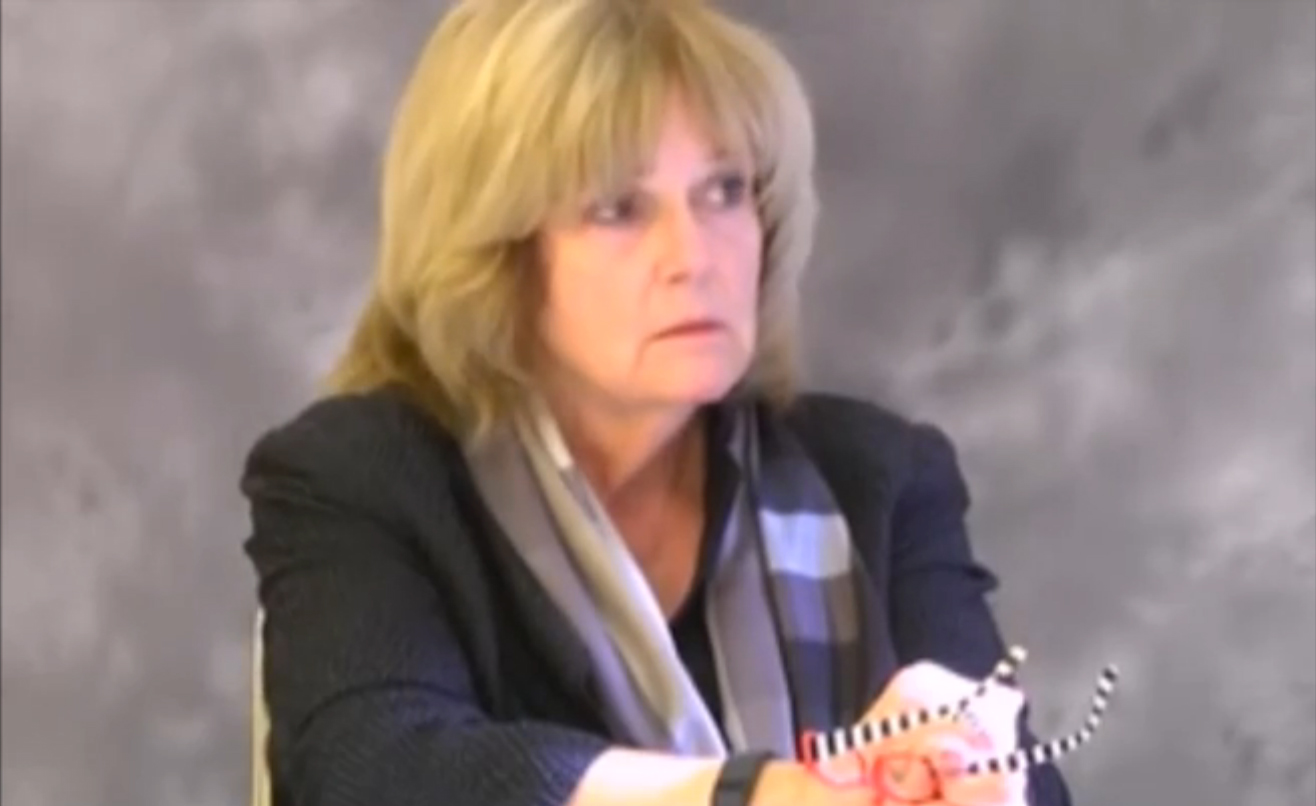 The crux of this back and forth comes at about the 4:30 point of the five minute video when Trinity East's lawyer, on behalf of his client, asks, "What is it they get for their $19 million dollars?"
The crux of this back and forth comes at about the 4:30 point of the five minute video when Trinity East's lawyer, on behalf of his client, asks, "What is it they get for their $19 million dollars?"
Suhm says Trinity East "got the right to apply" for SUP permits.
But those permits cost considerably less than $19 million. What was Trinity East really paying for with those leasing checks, and did they get their money's worth?
Allow us to defend Mary Suhm.
When Trinity East wrote those checks, Suhm was riding high as City Manager and her command over Council affairs was already legend, especially as she negotiated the city budget through very tight times. Trinity knew the signature of a mere elected official was not sufficient. Those come and go at City Hall with hardly anyone noticing. It wanted the boss's John Hancock on the document and the boss was Mary Suhm.
Besides a perfectly legal and hefty bribe when the City needed it during the Great Recession, Trinity was investing in the power of Mary Suhm and her relationships with the Powers-That-Be. The company had every confidence as the ring master of the downtown circus, Suhm could make things happen that otherwise wouldn't happen. She was in control.
Trinity East wasn't wrong – in 2008. Had they pursued their permit requests in the next one to three years, there's every likelihood Trinity East would have received them.
But the company waited until 2011.
What had happened in those intervening three years?
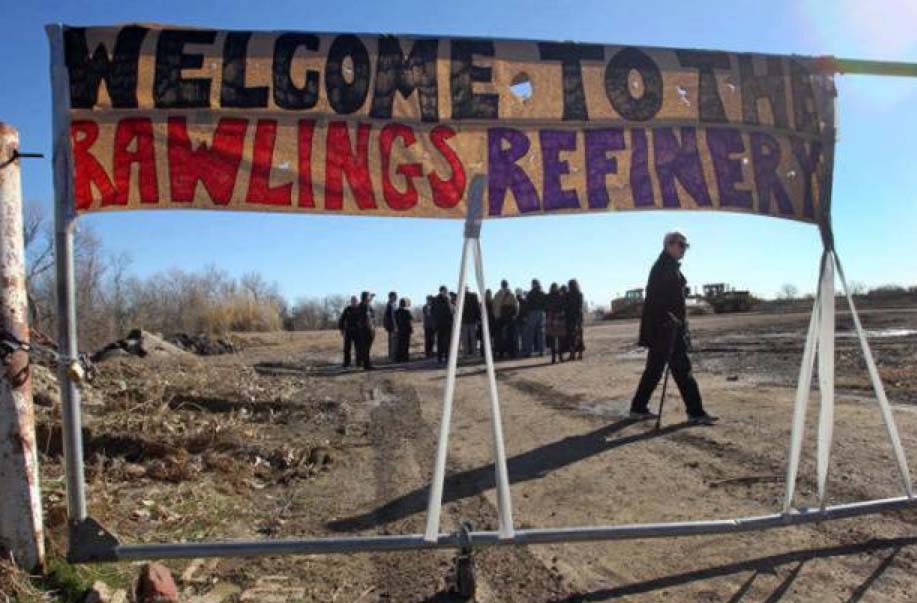
There was a drilling backlash beginning to reach full volume in the Barnett Shale, aided by a new national awareness of fracking as it spread to other parts of the country. Josh Fox's "Gasland" came out in 2010 and was nominated for an Academy Award in 2011. Burning tap water replaced a folksy Tommy Lee Jones as the face of gas drilling in North Texas. Citizen groups were sprouting in every city with drilling fighting for larger buffer zones and more pollution controls. There were stories in the media all the time. Because no health or environmental studies had been done on urban fracking, all kinds of new ones were launched or just being reported on for the first time.
In light of the new controversy, Councilwoman Angela Hunt helped drive the City to convene a gas drilling task force, giving residents a chance to organize around the issue before Trinity East even applied for their permits. Every concern – air, water, even earthquakes – that would later become ammunition for opponents showed up in this task force process first.
Scott Griggs ran for Dallas City Council from one of the districts targeted by new gas drilling permits and won on an anti-drilling platform against an incumbent. He joined Hunt as a fierce critic of Dallas urban drilling. Neighborhoods were showing new muscle.
And so the stage was set for more of an uphill fight than what Trinity probably would have confronted in 2010.
Mary Suhm must have taken note of some of this and sighed when Trinity finally put in for its permits. Now they show-up?
Still, let the record show she put on a stiff upper lip and gave 110% to the cause of getting Dallas City Hall to approve Trinity East's permits. She contorted bureaucracies. She muscled appointees and council members alike. She and her staff worked overtime to try to subvert every move of the growing opposition to Trinity East's permits. When the company lost, it wasn't because Mary Suhm didn't pull out all the stops, but despite the fact she did.
Now, we're pretty sure this is a defense the City of Dallas lawyers don't want to use, but we offer it up here in case they need to break the glass and begin building firebreaks in court to keep from paying back the $19 million.
These are only the most egregious examples residents know about.
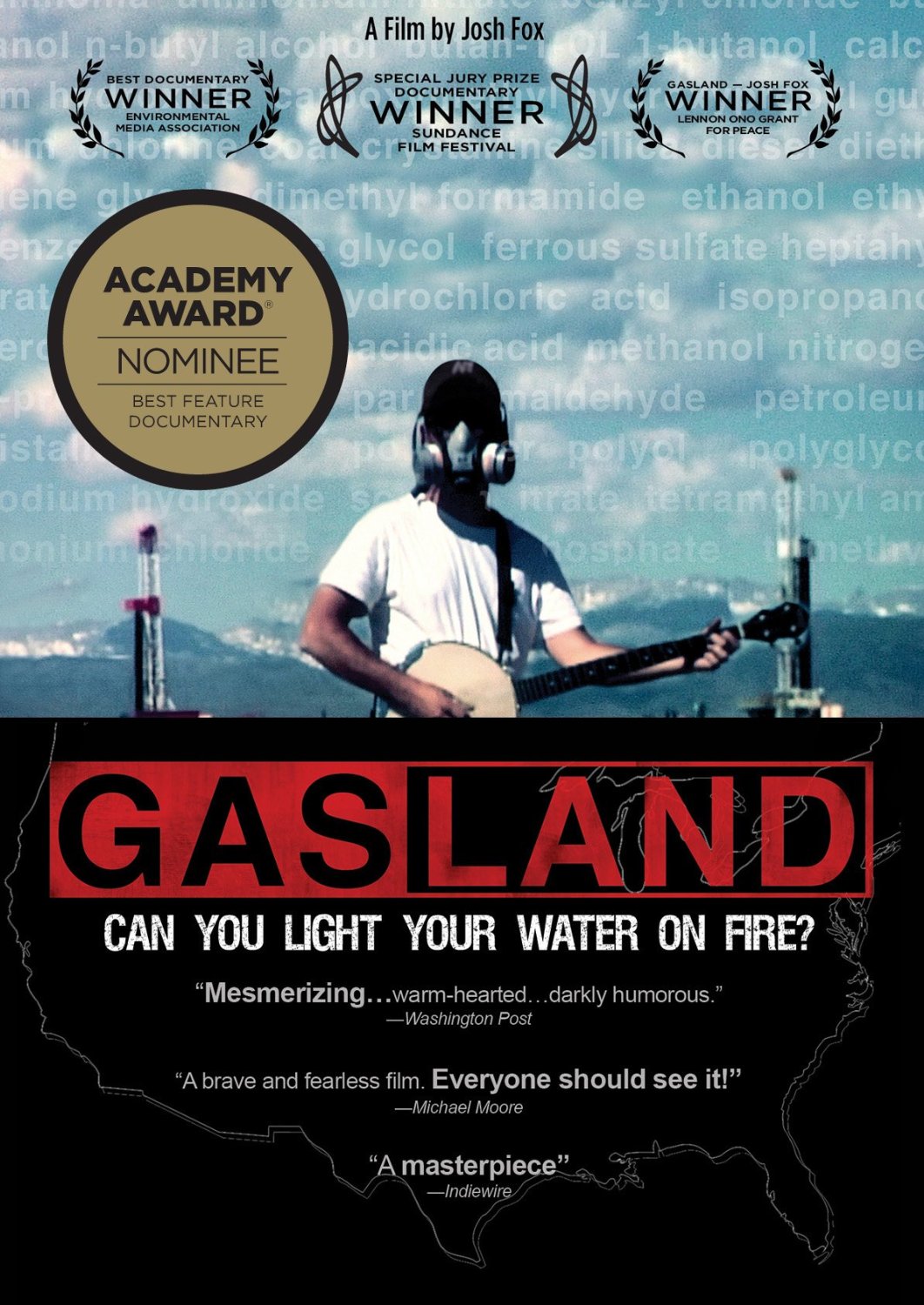
2011 Gas Drilling Task Force
In retrospect, it's easy to see Suhm's manipulation behind the last-minute Task Force endorsements of park and flood plain drilling. And when we say last-minute, we mean it.
Task Force members had already voted to keep the prohibition against drilling in these areas at a previous business meeting. The last meeting of the Task Force was supposed to be a pro forma affair that would ratify all previous recommendations and send them along to Council. Task Force member attendance was therefore down. This is when Task Force Chairwoman and former city council member Lois Finkelman chose to spring new votes on these two issues – and these two issues only – and won a reversal on each. Not only of the Task Force positions – but of current city policy, which of course didn't allow drilling in either area then.
Many excuses were used to justify this re-examination and re-vote that day, but none of them were the truth. Finkelman and staff were doing Suhm's bidding, and she was looking out for Trinity East. While it's not clear if Finkelman knew about Suhm's secret agreement, you can be sure Suhm, or someone on her behalf, made it clear to Finkelman it was VERY important to get these exemptions. Finkelman had been a friend to the clean air movement and other environmental causes during her tenure on the Council in the 1990's, but caved because of her relationship with Suhm, a belief she was helping the City out of a jam, or some other reason. At the end of the day, she weakened proposed city policy in accordance with what Trinity East wanted.
This is certainly something Trinity East got for its $19 million.
2012 Xmas Plan Commission Hearing on Trinity East Permits
Scheduled on December 20th, 2012, this was the first time gas drilling permits had been voted on for Dallas in three years, or pre-national outrage. It occurred before the Task Force recommendations had been considered and adopted into policy. In other words, after a call to reform its outdated drilling ordinance, and after a special Task Force had already been convened and issued its recommendations, Dallas was now about to grant three new permits, including one for a compressor station and refinery, under the old ordinance it was trying to replace. What was the rush? Why not wait and approve new permits until after the Task Force recommendations are written into a new ordinance? Because that would cause further public debate. More debate would highlight the problems of drilling in sensitive areas like park land and flood plains – still off limits in Dallas at the time.
In a transparent attempt to limit public awareness and participation even more, the City decided to hold this important hearing only five days before Christmas. Again, in retrospect, this has Mary Suhm's fingerprints all over it. And it almost worked. But just enough citizens showed up, representing enough well known groups and neighborhood organizations, and citing just enough new facts that had changed the situation since 2008 to win the climatic vote, 7 to 5 at 7:30 pm that evening. It was uncertain which way the decision would go right up until the very end.
Showing-up expecting to lose, instead citizens were elated. Overturning the denial would take a super majority of 12 votes on the Council – something that even then seemed unlikely. Citizens thought they had won. Mary Suhm had tried her best to rig the system, but the rigging failed. She tried again.
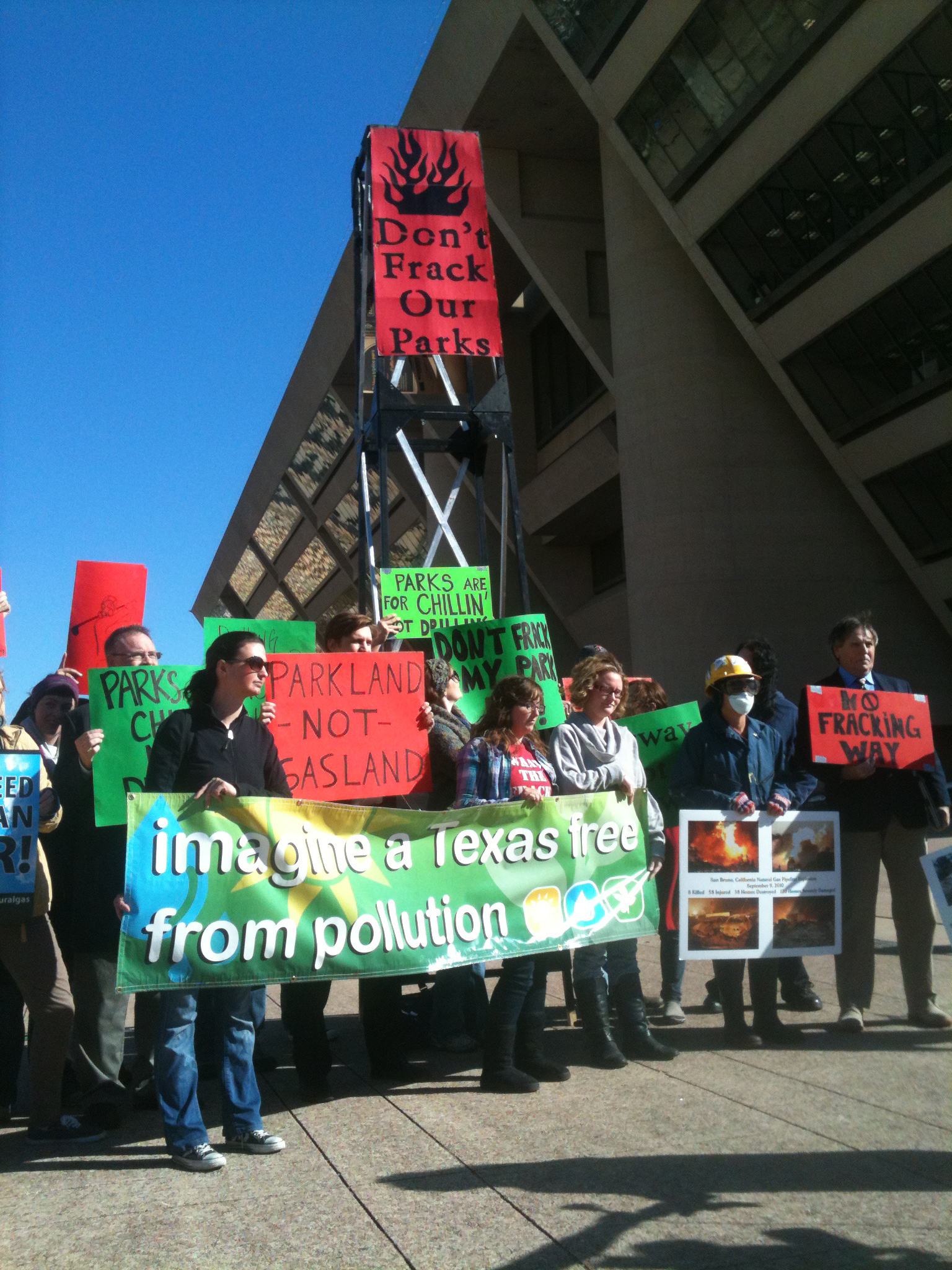
January- February 2013 Plan Commission "Reconsideration Vote" on Previous Permit Denial
Because she'd lost the December Plan Commission vote and knew she might not be able to get the 12 votes on the Council to overturn, Suhm had to do something creative. Viola! The Plan Commission would have a vote to "reconsider" their denial of Trinity East's permits only 21 days earlier. Nobody could remember the last time the Plan Commission even took such a vote. It was unprecedented. It was also Mary Suhm's handiwork.
That do-over decision came at a "special meeting" of the Plan Commission on January 10th, with a 6 to 5 vote to indeed take another vote on Trinity East's permits. This outcome, done under heavy police presence and with no public participation allowed, spurred one of the most iconic moments at Dallas City Hall in recent years – a 3 to five minute spontaneous standing crowd chant of "Shame."
You can see the speed at which Suhm is moving behind the scenes to engineer a better outcome after her unexpected defeat before Christmas. She's doing exactly what she promised Trinity East she would do. She's working the levers. Making things happen that would never otherwise happen. But now, it's costing her more to do so. The contortions of the system necessary to get the permits through are getting more twisted and harder to pull off gracefully. She's gone from talks with friends behind closed doors to forcing awkward "do-over" votes. It was obvious to the public there was something special about these Trinity East permits. Company officials had been dropping hints about some sort of an agreement with the City. Mayor Rawlings said permitting these sites "were a done deal" – although he didn't say why. It was getting messy.
Finally, on February 7th, the day the Plan Commission had scheduled the "do-over" vote, the Dallas Observer broke the story on the Suhm-Trinity East agreement. It was now clear what was driving the favoritism behind the treatment of the Trinity East permits by City Hall – going all the way back to the last-minute reversal of the Task Force, to the Christmas time hearing, to the pending "reconsider vote."
The timing could not have been worse for Suhm. We'll never know what the vote to reconsider might have been were there no headlines pointing to a City Hall cover-up. She may have thought she had the votes to keep the Trinity East permits alive. But with the story breaking that very day, the spotlight was too bright on the Plan Commission to take a new vote. Citizens won a reprieve and eventually a victory as the Commission requested the City Council deal with changing the current prohibitions against parkland and floodplain drilling before asking them to violate current ordinances again. That never happened. Instead, the three Trinity East permits were again denied by the Plan Commission in March 2013, albeit by razor-thin 8 to 7 and 9 to 6 margins.
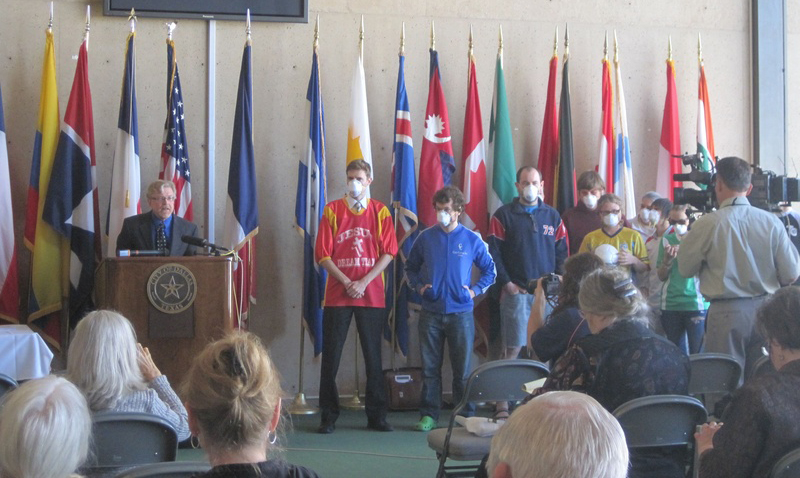 And that was that. Suhm was gone in four months. Officially it wasn't because of the cover-up of the Trinity East agreement, but of course everyone knew it was because the whole thing was headed to court one way or the other.
And that was that. Suhm was gone in four months. Officially it wasn't because of the cover-up of the Trinity East agreement, but of course everyone knew it was because the whole thing was headed to court one way or the other.
Although the Mayor tried to rally 12 votes on the Council to overturn, he couldn't do it. The prospect of the kind of rolicking citizen protests keeping the Plan Commission on the 6 o'clock news showing up at a Council Meetings could not have helped his cause at this point.
Urban fracking opponent Philip Kingston had replaced Hunt on the Council, Griggs was still there, and they were joined by enough other council members (Sandy Greyson, Monica Alonzo, Carolyn Davis, and Adam Medrano) to insure the Plan Commission vote would prevail.
At the end of the day, Trinity East walked away empty-handed. but make no mistake about it. Mary Suhm did all she could to subvert the system for Trinity East.
Had the Dallas Observer not revealed the secret agreement, she might have even won the day for the company and still be City Manager. Was it $19 million worth of subversion? At today's inflated rates, who knows? But other than funding a small army and declaring herself dictator of the Drilling Republic of Dallas, she did all she could.
If you're Trinity East you can complain about the outcome, but you can't complain about her effort. There were too many variables out of her control for once. Not the least of which was a vigorous, rowdy, neighborhood-based movement against urban fracking in Dallas that was taking the fight to the public square…and winning. Sometimes, even the most powerful City Manager is on the wrong side of history.
It’s a Texas vs EPA Cage Match. Winner Takes All …The Air You Breathe
 JOIN OUR TAG TEAM EFFORT TO TAKE DOWN THE STATE OF TEXAS
JOIN OUR TAG TEAM EFFORT TO TAKE DOWN THE STATE OF TEXAS
BUT WATCH OUT – THEY PLAY DIRTY
NEXT THURSDAY EVENING
JANUARY 21st
6:30 PM
616 Six Flags Road
First Floor HQ of the
North Central Texas Council of Governments
There's an important bureaucratic cage match between EPA and the State over how clean your air should be.
The state says just by hitching a ride on already-in-progress federal gasoline mix for cars and trucks, DFW ozone, or smog, will drop to levels "close enough" to the current federal smog standard of 75 parts per billion (approximately 78 ppb) . No new cuts in pollution required.
The EPA says not so fast – "close enough" may not be good enough this time around and you're not following the Clean Air Act in laying back and requiring no new cuts in pollution.
EPA has told Austin a failure to follow Clean Air Act rules will force it to take responsibility for the plan away from the State.
Is this something you want? If so, you should show up and next Thursday evening to give the EPA the political support it needs to pull the rug out from under the State.
WHAT HAS THE EPA ALREADY SAID ABOUT THE STATE'S PLAN?
Along with comments from DFW residents, environmental groups, doctors, industry and elected officials, EPA itself will weigh-in with written comments on the TCEQ plan by the deadline of January 29th.
But we don't have to wait that long to find out what EPA really thinks about what the State is proposing. Last year, EPA provided 11 pages of comments on exactly the same plan.
1) This plan won't work without more cuts in pollution
What EPA Said:
"Based on the monitoring data and lack of additional large reductions in NOx within areas of Texas that impact DFW, it is difficult to see how the area would reach attainment in 2018 based solely on federal measures reductions from mobile and non-road….The recent court decision that indicates the attainment year will likely be 2017 for moderate classification areas such as DFW, makes it less clear that the area will attain the standard by 2017 without additional reductions."
What EPA Meant:
It wasn't looking good when the deadline for reaching the 75 ppb standard was 2018 and the State didn't require any new cuts in air pollution, but now that the deadline is 2017, your do-nothing "close enough" plan is even less likely to work.
2) Your case for doing nothing isn't very good
What EPA Said:
"While the State has provided a large chapter on Weight of Evidence, the principal evidence is the recent monitor data. The monitor data does not show the large drops in local ozone levels and therefore raises a fundamental question whether the photochemical modeling is working as an accurate tool for assessing attainment in 2018 for DFW."
What EPA Meant:
Actual measurements of smog in DFW seem to undercut your claim that the air is getting cleaner faster. Maybe your computer model that's driving the entire plan isn't all that great. (And this was before smog levels went UP after the summer of 2015 – something not predicted by the State's model….)
3) Review pollution limits for the Midlothian cement kilns, or we'll reject your plan
What EPA Said:
"Because of significant changes in the type and number of cement kilns in Ellis County,…TCEQ's rules need to be reevaluated to insure these reductions are maintained, and the emission limits reflect a Reasonably Available Control Technology (RACT) level of control as required by the Clean Air Act…Failure to conduct a thorough RACT analysis for cement kilns which would include appropriate emission limits would prevent us from approving the RACT portion of the attainment plan submittal."
What EPA Meant:
Update your kiln pollution limits, or this part of the plan is toast. (Texas chose not to perform this update, in essence, giving EPA the bureaucratic finger.)
4) Oil and Gas pollution seems to be keeping the region's smog levels higher than they should be
What EPA Said:
"Recent NOx trends (Figure 5-10 in TCEQ's Proposal) indicate a fairly flat NOx trend for several NO monitors in the western area of the DFW area (Eagle Mtn. Lake, Denton, and Parker County monitors). These monitors are in areas more impacted by the growth in NOx sources for Oil and Gas Development that seem to be countering the normal reduction in NOx levels seen at other monitors due to fleet turnover reductions (on-road and Nonroad). These higher NOx levels in the modeling domain that seem to be fairly flat with no change since 2009
raise concern that the area is not seeing the NOx reductions needed to bring the ozone levels down at these monitors."
What EPA Meant:
Since the historically worst-performing air pollution monitors in DFW are located in exactly the same area as a lot of gas and oil activity, and these monitors haven't been seeing the expected decrease in smog you predict, maybe you ought to think about cutting pollution from those oil and gas sources. Like we said, this plan needs more cuts in pollution.
5) Your own evidence supports cuts in pollution from the East Texas Coal Plants
What EPA Said:
"The TCEQ provided an evaluation of emissions from all of the utility electric generators in east and central Texas. However, the discussion in Appendix D on the formation, background levels, and transport of ozone strongly supports the implementation of controls on NOx sources located to the east and southeast of the DFW nonattainment area. How would a reduction in NOx emissions from utility electric generators in just the counties closest to the eastern and southern boundaries of the DFW area impact the DFW area?"
What EPA Meant:
Despite your protests, the State's own analysis shows cuts in pollution from the East Texas Coal Plants have a big impact on DFW smog levels and supports the argument for putting new controls on them. Did you actually run your fancy-dancy computer model to see what would happen if you did that? (No, the State did not. But UNT and Downwinders did.)
WHY WOULD AN EPA PLAN FOR DFW AIR MAKE ANY DIFFERENCE?

If the EPA rejects the State's plan, the clock begins ticking: the State is warned it has to write a new plan and, meanwhile, EPA begins to write its own. If the State doesn't turn in a plan the EPA finds acceptable in 24 months, the EPA plan is implemented instead.
The State has no interest in any new cuts of pollution from any sources. It thinks it's plan is already "close enough."
If the EPA is writing the plan, citizens can use the new UNT study to show the Agency which cuts get the largest drops in smog – using the State's own air model.
We can use Dr.Haley's study to show the approximate economic and public health benefits of those cuts.
More change happens if EPA is writing the plan.Enough to finally get DFW safe and legal air? We don't know until we try. The alternative is doing nothing.
Why DFW Residents Should Speak in Favor of a Lower Smog Standard at Thursday’s EPA Public Hearing in Arlington

All Day NATIONAL Public Hearing on a New Federal Ozone Standard
Thursday, January 29th, 9am to 7:30 pm
Arlington City Hall, 101 W. Abram
There are only three national public hearings on the possibility of lowering the national federal ozone, or smog, standard. One is in Washington DC, another is in Sacramento, California and the third is right here in Arlington, Texas. We need everyone that can come and speak for 5 minutes on the importance of cleaner air to do so. You know industry and elected officials hostile to the EPA and the Clean AIr Act will be well-represented
To secure your 5-minute speaking slot, e-mail Eloise Shepard and ask for one in the time period during the day on Thursday most convenient for you. Please do it asap: shepherd.eloise@epa.gov.
There are at least two very good reasons why North Texas residents should support a new lower smog standard of 60 parts per billion – the lowest standard under consideration by the EPA.
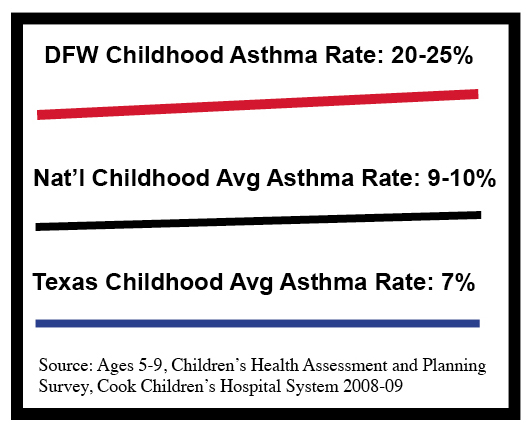 1. DFW has Epidemic Childhood Asthma Rates
1. DFW has Epidemic Childhood Asthma Rates
According to a first-of-its kind survey in 2008 by Cook Children’s Hospital, one out of every four DFW children ages 5-9 suffered from asthma. That was more than twice the national average, and more than three times the average for the state of Texas. Asthma is the most common cause of missed school days and is one of most common causes of Emergency Room visits and hospitalizations.
The DFW Hospital Council estimates nearly 1500 children in Dallas County visited an emergency room or were admitted to a hospital due to asthma in 2012. Dallas County has the highest number of child asthma hospitalization in the state.
According to EPA itself, a new 60 parts per billion (ppb) standard for ozone would eliminate roughly 1.8 million asthma attacks, 1.9 million missed school days, and 6,400 premature deaths nationwide – 95% of all ozone-related deaths. Few regions would benefit more from such a lower ozone standard than DFW.
2. It’s One of the Few Ways to Force Reductions in Harmful Air Pollution in Texas 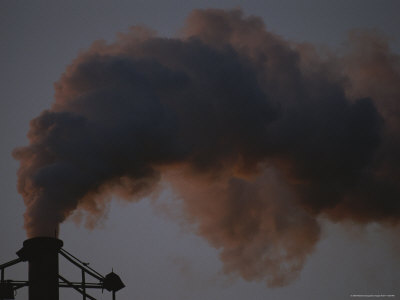
Texas is a place where industry rides rough shod over state regulators and citizens don’t have a level playing field to seek relief from the adverse health consequences of air pollution. Tougher federal ozone standards are one of the only ways to reduce air pollution from large local sources like the cement kilns in Midlothian, gas facilities in the Barnett Shale, and coal plants in East Texas.
Lower federal ozone standards over the last two decades, combined with grassroots campaigns have resulted in the lower volumes of smog pollution from the Midlothian cement kilns, plus reductions in other kinds of harmful pollution from the kilns as well, like particulate matter, and carcinogens. A new 60 ppb ozone standard would mean the kilns would have to add state-of-the-art controls to bring down those totals even more – to as much as 90% reductions. The same is true with the East Texas coal plants and with polluting gas facilities. To get down to 60 ppb ozone levels in DFW could mean deep cuts from the largest sources of industrial air pollution in North Texas. Something that probably won’t happen without a new, lower federal ozone standard.
And that won't happen without a lot of you showing up on Thursday to say you want and need cleaner air to breathe. Reserve your 5-minute speaking slot now. It's a good investment if you live in Texas.
The Mansfield Fight Goes National And Industry Gets Worried
 We must be doing something right.
We must be doing something right.
Last Thursday, Energy in Depth, the national PR arm of the oil and gas industry, singled out Downwinders at Risk for our support of longer setbacks between people and gas industry facilities in Mansfield and other North Texas cities.
EID calls these setbacks, now passed in DISH, Denton, Southlake and Dallas, "defacto bans" because they require wells and compressors to be anywhere from 1000 to 1500 feet from homes, schools, park and other "protected uses" – to use city zoning lingo.
But of course these setbacks are defacto bans only because industry wants them to be – not because there are any technical obstacles to them reaching the gas underneath these cities due to distance. Gas operators can now punch a hole and reach deposits up to at least a mile or two away from where they place their rig on the surface. That's more than three 1500-foot setbacks end-to end. Operators have to spend more to drill to get that gas, but that's the price they pay for trying to place heavy industry in the middle of residential areas, parks, or near schools – something most cities don't allow when it comes to hazardous waste incinerators, chemical plants or landfills. Part of the problem is the inherent arrogance of the gas industry's position – it wants to pollute like a heavy industry, but it doesn't want to be regulated like one.
You know the folks in Corporate are getting worried when these things pop up on the Energy in Depth agenda. They understand their much-beloved "Fort Worth model" of less protective 600-foot setbacks and looser regulations in now under organized assault. While the rest of us see a constant barrage of new studies coming out every month emphasizing the dangers to human health of proximity to gas facilities, the industry wants time to stop in 2010, before we knew so much. But time marches on. And so does knowledge, and then public opinion.
Mansfield is deep into the Shale. It shares a border with Ft. Worth, unofficial headquarters for the Barnett Shale Energy in Depth crowd. A rejection of Cowtown's approach to regulating the gas industry here would be a major setback to the industry. The stakes are high. Just in the last week, two national publications, a subscription-only national newsletter called Environment and Energy Daily, and the Center for Public Integrity, have posted stories on the Mansfield fight. They've hit a nerve. That's why Energy in Depth is writing about it.
Getting criticized by EID is recognition that the partnership between Mansfield Gas Well Awareness and Downwinders at Risk is having an impact. We consider is a badge of honor. Our only regret is that it came too late to be used in our traditional end-of-year fundraising letter. Because after months of frustration, Mansfield residents are finally getting the attention they and their complaints deserve from their city council and the media. It's a national fracking fight hotspot. That's not an accident. That's good organizing.
Make Your Butt A Force for Good Tonight
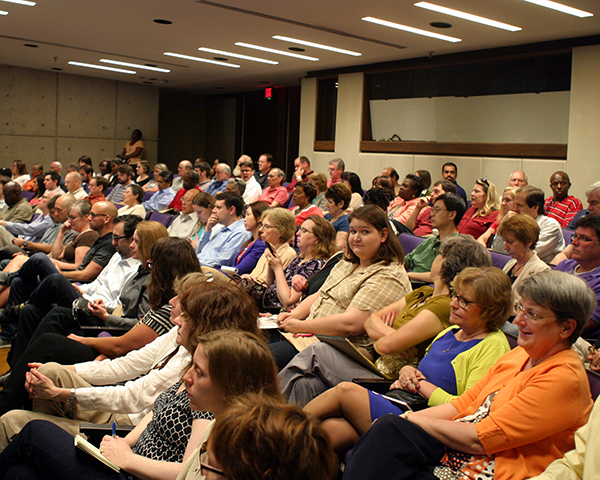 Woody Allen is famously credited with the line that "showing-up is 80% of life." With organizing, it's more like 90%. There are at least two places to be tonight where just your butt in a seat will make a huge, positive difference:
Woody Allen is famously credited with the line that "showing-up is 80% of life." With organizing, it's more like 90%. There are at least two places to be tonight where just your butt in a seat will make a huge, positive difference:
1) Mansfield City Council Work Session on a New Gas Drilling Ordinance, 6 pm, Mansfield Performing Arts Center Workroom, 1110 West Debbie Lane, (near Hwy 287 – just south of I-20) (map).
After almost a year of struggle, residents of Mansfield are getting a hearing tonight in front of their city council. Unfortunately, the council, including two members who make a living from the gas industry, are making the the residents take on the Texas Commission on Environmental Quality, the Texas Railroad Commission, 10-13 gas industry representatives, pro-industry state representatives, senators, and Congressman, as well as their own city staff – all in one evening. They're besieged, and they really need your help tonight.
We have it on good authority that the Mansfield Mayor is using this set-up to "gauge public opinion on the issue" even though members of the public won't get to speak. So it's all about attendance – butts in seats.
Mansfield isn't Dallas. It isn't Denton. It's not even Southlake or Flower Mound. It's deeper into the Shale, more blue collar, and more pro-industry than any other city that's been challenged over their old drilling ordinance in the last several years. The city has more gas wells now per capita – over 200 in a city of 60,000 – than just about any other place in North Texas – with a potential for 300 more. Concerned residents are at a disadvantage in trying to change the status quo.
Just your being there in a seat tonight sends a message you care about this issue. And if you live in Tarrant county or any place else where there's gas drilling in the Metromess, it's in your own self interest to help them in Mansfield. A victory there will make it more possible to win in other places. It will mean less air pollution from their wells and compressors blowing downwind. It will mean the tide is moving further west.
So do yourself, the region, and the cause a favor and show up tonight. You don't even have to speak. You just have to be present to win.
2) Trinity Toll Road Debate – 6:30 p.m. at Rosemont Elementary School, 1919 Stevens Forest Drive (map)
State Representative Rafael Anchia is sponsoring this debate over this leftover 20th Century boondoggle that features almost all the major players on both sides of the issues – Michael Morris, Mary Suhm, Patrick Kennedy and Scott Griggs. Again, your presence sends a valuable signal – that you're opposed to this floodplain toll way, and that this will be an important issue in the May Dallas elections. Go and be active members of the peanut gallery – cheer on the opponents, jeer the supporters.
It's particularly important that the public show increased interest tonight as Suhm and Mayor Rawlings conspire to muddy the waters with a new "review" of the plans of the road. They hope to give Citizen Council-backed candidates in the May election a way out of a simpey yes or no answer to the Toll Road – by saying their waiting for the review. You need to make sure they get the message that nobody is falling for that ruse.
Your butt can be a powerful voice for change tonight, or it can sit on the couch. Get out and show-up.
Can You Spot the Mistake in This Map?
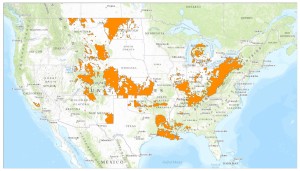 Here's why there's a missing big orange splotch….or two….or three, in Texas in this new national map of oil and gas well concentration.
Here's why there's a missing big orange splotch….or two….or three, in Texas in this new national map of oil and gas well concentration.
New UNT Study-In-Progress Links Gas Pollution to Persistent DFW Smog
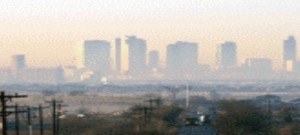 This is why it's important for citizens to have real scientific horsepower.
This is why it's important for citizens to have real scientific horsepower.
DFW has a smog problem. It's not as bad as it used to be, but it's still at unsafe and illegal levels. And for the last four or five years, the air quality progress that should have been made has been stymied. Despite almost all large sources of smog-producing pollution being reduced in volume, our running average for ozone is actually a part per billion higher than it was in 2009.
Many local activists believe this lack of progress is due to the huge volumes of smog-producing air pollution being generated by the thousands of individual natural gas sites throughout the DFW region itself, as well as upwind gas and oil plays. In 2012, a Houston-based think tank released a report showing how a single gas flare or compressor could significantly impact downwind smog levels for up to 5 mile or more. Industry and the Texas Commission on Environmental Quality say no, gas sources are not significant contributors to DFW smog. In fact, during this current round of planning, the state has gone out of its way to downplay the impact of gas pollution, including rolling back previous emission inventories and inventing new ways to estimates emissions from large facilities like compressor stations.
Into this debate steps a UNT graduate student offering a simple and eloquent scientific analysis that uses the state's own data on smog to indict the gas industry for its chronic persistence in DFW – especially in the western part of he Metromess, where Barnett Shale production is concentrated.
On Monday night Denton Record-Chronicle reporter Peggy Heinkel-Wolfe gave a summary of a presentation on local air quality she'd sat through that day at UNT:
"Graduate student Mahdi Ahmadi, working with his advisor, Dr. Kuruvilla John, downloaded the ozone air monitoring data from the Texas Commission on Environmental Quality back to 1997, a total of more than 6.5 million data points, he said, and has been studying it for the past four months.
Ahmadi wanted to explore a basic question underlying a graphic frequently distributed by the TCEQ that shows gas wells going up in DFW as ozone goes down, which suggests in a not-very-scientific-at-all way, that the increasing number of gas wells is having no effect on the ozone.
Ahmadi adjusted for meteorological conditions to determine how much ozone DFW people are making and where. Such adjustments have been explored by others to understand better the parts of ozone-making we can control, because we can’t control the weather. He used an advanced statistical method on the data, called the Kolmogorov-Zurbenko filter, to separate the effects of atmospheric parameters from human activities.
According to the results, the air monitoring sites surrounded by oil and gas production activities, generally on the west side of DFW, show worse long-term trends in ozone reduction than those located farther from wells on the east side of DFW.
His spatial analysis of the data showed that ozone distribution has been disproportionally changed and appears linked to production activities, perhaps an explanation why residents on the western side of DFW are seeing more locally produced ozone, particularly since 2008.
Ahmadi's results are not definitive, and the paper he's writing is still a work-in-progress. But he's asking the right questions, and challenging the right unproven assumptions. He's at least put forth an hypothesis and is trying to prove or disprove it. He's using science. TCEQ's approach is all faith-based.
Anything that takes the focus off vehicle pollution is anathema to Austin and many local officials who want to pretend that industrial sources of air pollution don't impact the DFW region enough to make a difference so they don't have to regulate them. If there's a guiding principle to TCEQ's approach to this new clean air plan, due in July 2015, it's to avoid any excuse for new regulations while Rick Perry is running for President. The agency isn't interested in doing any kind of science that might challenge that perspective – no matter how persuasive. After all, you're talking about a group that doesn't believe smog is bad for you. TCEQ doesn't want to know the truth. It can't handle the truth. It's got an ideology and it's stickin' to it.
So it's up to young lowly graduate students from state universities armed only with a healthy sense of scientific curiosity to step up and start suggesting that the Emperor's computer model has no clothes, and offering up alternative scenarios to explain why DFW air quality is stuck in neutral. It turns out, just doing straight-up classroom science is enough to threaten the fragile House of Computer Cards with which the state's air plan is being built.
Perhaps equally as ominous for the success fo any new clean air plan is Ahmadi's discovery that ozone levels in DFW have been during the winter time, or "off-ozone-season." There could be a new normal, higher background level of smog affecting public health almost year round.
Mahdi Ahmadi's study is just one of the many that need to be done to construct an honest clean air plan for DFW, but it shows you what a curious mind and some computing power can do. Citizens can't trust the state to do the basic science necessary as long as the current cast of characters is running the show in Austin. EPA won't step in and stop the farce as long as TCEQ can make things work out on paper. If the scientific method is going to get used to build a better DFW clean air plan, it's going to have to be citizens who apply it.
Sloshing Back and Forth Between Coal and Gas
 Around 2003 or so, the Dallas Morning News editorial board convened a roundtable of air pollution stakeholders and more or less facilitated a discussion of what could be done to clean up DFW's dirty air. You see, the area still hadn't complied with the 1997 national smog standard and more and more official air quality monitors were in violation of it. Pretty much, just like now.
Around 2003 or so, the Dallas Morning News editorial board convened a roundtable of air pollution stakeholders and more or less facilitated a discussion of what could be done to clean up DFW's dirty air. You see, the area still hadn't complied with the 1997 national smog standard and more and more official air quality monitors were in violation of it. Pretty much, just like now.
There was a memorable moment when one of the "environmentalists" at the table noted that for decades the Texas utility industry had been primarily reliant on natural gas for its power source, then switched almost entirely to coal during the 70's and 80's, exactly when the nation's first national air quality standards were being written and enforced. "Part of the problem is that there doesn't seem to have been any planning for the consequences of the industry switching over from one source to the other just like that. It's like a frenzied mob group of stockbrokers running back and forth between bidders."
"That's the marketplace," huffed a utility industry representative. And indeed it still is. One frenzied run after another back and forth between the two largest sources of fossil fuel.
You know the scene in Pirates of the Caribbean, At World's End where the crew runs back and forth, from each side of the ship, until it eventually turns upside down? It's like that, only with money doing the running. And it never ends.
That DMN discussion was only a decade ago. What happened next shows how quickly those runs can reverse themselves and the conventional wisdom. Fracking technology delivered new shale plays that flooded the market with new gas. So much new gas, that the price of it dropped to historic lows. That caused a huge switch in the utility industry. Gas was cheaper, so the coal-powered plants started to close and be replaced by gas-powered plants. At the same time the chemical industry, which uses voluminous amounts of gas in production of plastics and other products, announced a new wave of domestic construction because of cheaper gas supplies in the US. Finally, in order to prop-up the low gas prices that that are killing profits, the gas industry itself promoted the fuel for transportation use and export.
And students, what happens when all these elaborate plans to take advantage of cheap gas begin to blossom? Demand increases. Cheap gas turns into not-so-cheap gas. And then coal begins to look pretty good again. All of a sudden it's the negative image of 2003, and all that money is starting to run toward coal as gas prices rise.
And what that means is that the higher methane levels causing climate change are replaced by higher CO2 levels causing the same climate change. This is why we need to get out of the rut we're in where our choices are determined by short-term financial gain and not long-term survival.
Government puts its finger on the scales in the marketplace all the time to help this or that industry. Without government guarantees, whole sectors of the economy would not be able to function in a completely unfettered market. This is what the CO2 cap and trade system was designed to do – make the marketplace respond to pressures put there by government in order to achieve a goal of reducing the stuff that will make the place we live less habitable. But it was all a communist plot,or something like that. So in the meantime, we continue to slosh back and forth.
From the Houston Chronicle comes this summary of the latest trends:
After years of declining greenhouse gas emissions, Texas and other states reported sharply higher levels of carbon dioxide in 2012 as electric generating plants began to use more coal when natural gas prices began to rise, according to a study released Thursday.
Citing research done by the Environmental Integrity Project, Texas once again led the nation in CO2 from power plants in 2012, emitting 251 million tons. Florida was a distant second at 120 million tons. Just five states accounted for one-third of the nation's CO2 power plant emissions. Besides Texas and Florida, they include Pennsylvania, Indiana, and Ohio. Needless to say. the old TXU plants in East and Central Texas run by corporate off-spring Luminant are the largest contributors.
The price of gas will continue to go up and coal will be competitive. Or maybe it will go down and coal won't be attractive. Maybe we'll be downwind of lots more coal plant pollution. Or maybe we'll all have a rig or compressor station in our backyard. Who can say? That's the marketplace! The question is, do you want to bet our survival on it?
Dallas Fracking Mystery Tour
Time to Push Back and Make Some History
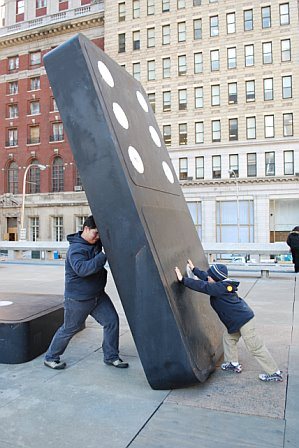 Dallas Plan Commission Public Hearings on Trinity East Gas Permits, including the "Rawlings Refinery"
Dallas Plan Commission Public Hearings on Trinity East Gas Permits, including the "Rawlings Refinery"
Thursday, 1:00 pm
6th Floor Dallas City Hall, City Council Chambers
When the Dallas Plan Commission held its January 10th vote to "reconsider" the denial of gas permits to Trinity East, it didn't allow any public testimony at all about the dangers posed by these proposed drilling and production sites.
Tomorrow it will. And we need you to come and add your body and your voice to this fight.
When the Mayor and City Manager first cooked up this scheme to ram through the last three gas permits in Dallas, they didn't expect to have any roadblocks. They scheduled a meeting five days before Christmas and thought they had it locked up.
They were wrong. You showed up anyway and the Plan Commission voted to deny the permits based on your impassioned pleas for public health and safety.
When City Hall didn't like the results of that vote, and pulled the "reconsideration" stunt in January, 100 of you showed up on a work day to shame the CPC publicly in a meeting that received a huge amount of media coverage.
Now they're holding the second public hearing on these gas permits. We need a larger show of strength to demonstrate we're gaining momentum
We need you to personally come and tell the Plan Commission why it's a bad idea to allow drilling in floodplains and parks and build a refinery next to the city's largest soccer complex where thousands of kids will be playing every weekend.
We know it's getting tiresome, but when you show up at these meetings and hearings, you're helping us win this fight.
Slowly, but surely, your concerns and questions about these Trinity East permits are weighing them down and making it harder for them to get rammed through.
For example, because of your work, we're about to see a bi-partisan call for the Mayor to reject the refinery permit near the Elm Fork Soccer complex. That news will be announced at tomorrow's press conference starting at 1:00 pm.
There's also more in the works challenging the process the City is using to keep these "zombie" permits alive.
The tide is turning. But you have to keep showing up.
Nothing can take the place of a room full of angry citizens. Tomorrow, don't just watch history on TV or read about it the next day. Make history. Thanks.
